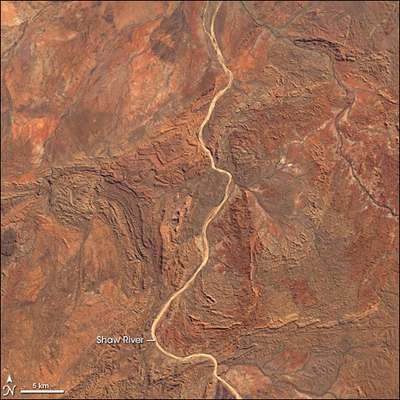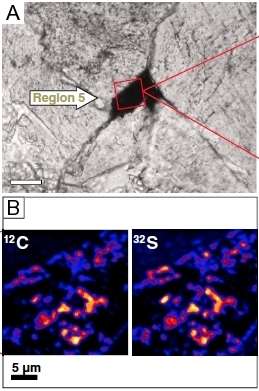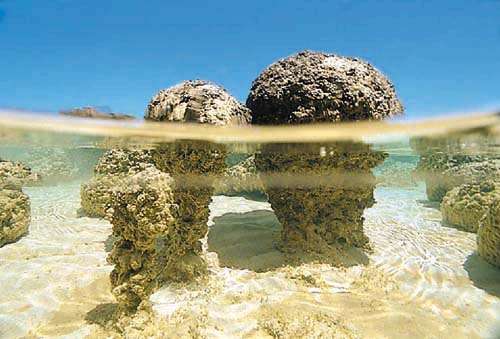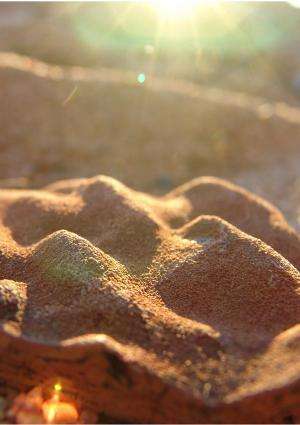The Strelley Pool Chert rock formation in Western Austrlia's Pilbara region is helping scientists answer questions about very early life on Earth. This picture is a composite of images acquired by the Landsat-7 satellite on May 19, 2000 (in the north), and June 23, 2001 (in the south). Credit: NASA image created by Jesse Allen, Earth Observatory, using data obtained from the University of Maryland’s Global Land Cover Facility
Researchers are providing new information about the 'diet' of microorganisms on the early Earth. By studying 3.45-billion-year-old rocks, the team uncovered clues about ancient microbial metabolism.
Australia is famous for its ancient, rugged landscapes of arid deserts and windswept rock formations. Some regions of the continent have remained relatively untouched by geology for over billions of years. Because of this, scientists have tramped all across the "sunburnt country" in search of clues about Earth's past biosphere and environment. Now, with some clever isotopic study, a team of scientists is using ancient Australian rocks to reveal information about the metabolic pathways used by microorganisms billions of years ago.
The Microbial Menu
The new study is the result of work undertaken in the Strelley Pool Chert rock formation in Western Australia by Tomaso R. R. Bontognali and colleagues. Strelley Pool is a region of active study for today's astrobiologists. The formation preserves an environmental record of the Earth in rocks that are estimated to be roughly 3.43 to 3.45 billion-years-old. Although the area is dry today, it was once submerged in shallow seawater where microorganisms would have thrived.
"The Strelley Pool Formation is an ideal site in which to look for evidence of past life because it has been only mildly affected by metamorphism, which is the main enemy of Precambrian geologists," says Tomaso Bontognali. "Metamorphism causes re-crystallization that alters the original sedimentary structures and causes degradation of fossil microorganisms that may have been present in the sediment."
The sedimentary structures that interest Bontognali are strange and ancient rock formations called stromatolies. Modern biological stromatolites on Earth are formed from the build-up of microbial mat communities that precipitate or "trap and bind" minerals, resulting in bulbous, mushroom-like rocks that protrude from the ground in shallow water. Astrobiologists have long been working to determine if the stromatolites in Strelley Pool were formed in the same way, and are therefore biosignatures of ancient life. One problem is that actual microbial fossils are rarely preserved in ancient stromatolites. Instead, astrobiologists must look for less direct evidence of their microbial architects. This includes comparing the morphology of ancient and modern stomatolites and chemical analyses of the materials they are made from. After years of study, the evidence for ancient life in Strelley Pool is looking promising.
(A) Transmitted light photomicrograph showing the organic-rich region analyzed by NanoSIMS. Scale bar, 20 μm. (B) NanoSIMS ion maps of 12C and 34S (red square in E). Credit: Bontognali et al., 2012
Lines of Laminae
The stromatolites from the Strelley Pool Formation contain what some scientists believe is direct evidence of possible microbial communities. Sandwiched in the rock are thin layers of sediment, known to geologists as 'laminae,' which are rich in organic carbon in the form of kerogen. It's these organic-rich laminae that make Strelly Pool stromatolites unique among other Archaen stromatolites, such as those found in the Barberton Greenstone Belt region, in South Africa. Bontognali's team wanted to see if they could add to the story, and have found some interesting evidence of what ancient microbes in the mat may have eaten.
Studying the diet of ancient microbes isn't as simple as with large, multi-cellular organisms. For instance, paleontologists can look at the teeth of dinosaurs and, based on the scratches and scrapes left by years of chewing, make a good guess at the types of plants and animals they ate. Microbes have no teeth, but they do leave a lasting mark on what they eat. Namely, their metabolism prefers specific isotopes of the same chemical element. Certain ratios (or fractionations) of isotopes can be linked to biological reactions, showing that the elements of interest were processed by microbes and not non-biological reactions or weathering.
For Strelley Pool, the team focused on isotopes of sulfur found in the kerogen laminae. They discovered fractionations consistent with an Archean sulfur cycle, indicating that sulfate-respiring microbes were at least living there when the mats were formed. This is also true for modern stromatolites – meaning that ancient and modern stromatolites may have more in common than their looks alone.
"Our results do not prove that sulfate-respiring microbes produced the stromatolitic laminations—they just indicate that sulfate-respiring microbes were present within the microbial mat," explains Bontognali. "This finding highlights important similarities between these early ecosystems and their modern counterparts. Sulfur-respiring microbes are commonly found at depth within modern microbial mats, and—in some lithifying mats—they play an important role in forming laminations. Thus, it is legitimate to hypothesize that similar biological processes might have contributed to the formation of the Strelley Pool stromatolites."
The results could provide valuable insight into biological processes used by Earth's ancient biosphere, and the biosphere's ultimate connection to the planet's environment.
This isn't the first time that scientists have examined sulfur fractionations in ancient rocks, but previous studies focused on minerals like pyrite (familiar to most people as 'fools gold') found outside the laminae of stromatolites. This is why Bontognali and his colleagues focused on sulfur contained in the kerogen, which would have recoded the sulfur cycle in a slightly different way. By comparing results from kerogen and pyrite, scientists are now more confident that the sulfur signatures are indeed evidence of ancient biology at work.
The stromatolites forming today in the shallow waters of Shark Bay, Australia are built by colonies of microbes. Credit: University of Wisconsin-Madison
According to Bontognali, "By measuring sulfur isotopes in kerogen, the geochemical evidence for metabolism can be directly linked to fossil material. The evidence is chemically encoded in the organic remains of the organisms themselves. This association reinforces any biological interpretation from previous studies and represents one of the main advantages of our new approach with respect to the classic measurements targeting sulfur minerals."
It is key that the numbers from the kerogen match previous studies by researchers like David Wacey of the University of Western Australia. "[Our work] measured sulfur isotopes in pyrite, whereas this new paper measured sulfur isotopes in organic material, and the data all matches," explains Wacey. "This is strong evidence that these sulfur metabolisms were active 3.4 billion years ago, and that they were active in more than one environment."
"This new research shows that the organic matter was probably biological and that sulfate-reducing and/or sulfur disproportionating bacteria were probably part of the biota," Wacey continued. "When put with data obtained from previous studies of the Strelley Pool material it certainly strengthens the case for these structures being biological stromatolites."
Fossil stromatolites in the Strelley Pool Formation. Credit: Abigail Alwood
A Brief History of Sulfur
Sulfur is essential for life on Earth because it is used in things like amino acids and proteins that keep cells alive. Today, microorganisms help to keep sulfur cycling on Earth so that it can be used by the rest of the biosphere. Understanding how and when sulfur metabolism developed on Earth can thereby help astrobiologists understand the origin, history and evolution of Earth's biosphere.
The strange thing is, previous studies on sulfur isotope ratios in sediments have limited ancient sulfur metabolism to only a few occurrences during the early Archean period on Earth. After this, they seem to disappear until the Paleoproterozoic, more than a billion years later. This has led some scientists to believe that the isotopic fractionation of sulfur in these ancient rocks is not actually evidence of Archean microbial activity. Instead, the ratios of sulfur isotopes were caused by other abiotic processes.
"The fact that there is a gap between the first isotopic evidence for sulfur metabolisms (i.e. ~3.5 Gyr ago) and the time when evidence for such metabolism is clearly and continuously recorded in the rock record (i.e. ~2.5 Gyr ago) raised doubts about the biological origin of the oldest pyrites," says Bontognali. "Our study provides an independent evidence for the early onset of sulfur metabolisms, indicating that the gap, although unexplained, may be real."
Building toward the future
The methods used by the team could also have further application in studying other ancient fossils.
"The same approach that we used for investigating the Strelley Pool stromatolites can surely be applied to assess the biogenicity of other putative fossil organisms present in the geological record," explains Bontognali. "But more studies on the effect of secondary processes are required to conclude whether organic sulfur or sulfur minerals provide the most reliable signal of a primary microbial process." However, when thinking about using similar isotopic studies beyond Earth in the hunt for biosignatures in our solar system, there are still too many technological barriers.
"The technique of measuring multiple sulfur isotopes from small amounts of organic material will undoubtedly be useful for further studies of early life on Earth," says David Wacey. "However, one needs to be careful in drawing conclusions from such isotopic data. A firm understanding of the age, geological setting, and post-depositional history of the organic matter being studied is needed before the sulfur isotope data can be interpreted correctly. The technique is not suited for remote studies on Mars for example. Samples would have to be returned to Earth for this technique to be applied. "
The techniques used in this study may be a bit complex for a robot searching for biosignatures on Mars, but they are shedding new light on ancient life closer to home. Not only are astrobiologists gaining a more complete picture of what microbial ecosystems on early Earth might have looked like – but they are also beginning to understand what was on the ancient Earth's microbial 'menu.'
The work was supported in part by the NASA Exobiology and Evolutionary Biology program. Further support came from the Caltech Center for Microanalysis and the Swiss National Science Foundation.
The paper, "Sulfur isotopes of organic matter preserved in 3.45-billion-year-old stromatolites reveal microbial metabolism," was published in the Proceedings of the National Academy of Sciences (PNAS) under lead author Tomaso R.R. Bontognali.
More information: Meyer B, Kuever J (2007) Phylogeny of the alpha and beta subunits of the dissimilatory adenosine-5'-phosphosulfate (APS) reductase from sulfate-reducing prokaryotes—origin and evolution of the dissimilatory sulfate-reduction pathway. Microbiology, 153(Pt7),2026-2044.
Wacey D, McLoughlin N, Whitehouse MJ, Kilburn MR (2010) Two coexisting sulfur metabolisms in a ca. 3400 Ma sandstone. Geology 38:1115–1118.
Journal information: Proceedings of the National Academy of Sciences , Geology
Source: Astrobio.net

























